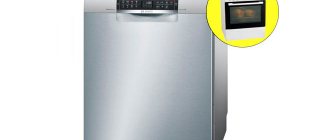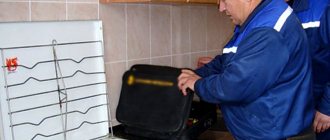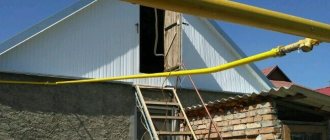When renovating a kitchen or simply updating it, numerous questions arise: how and where to place kitchen units and household appliances. It is especially important to think through everything when the room is small and it is difficult to place everything at a sufficient distance.
Is it possible to place a gas stove next to a refrigerator? Isn't this dangerous? Can I get a fine for incorrect placement? In this article we will answer these questions in detail and offer solutions for compact kitchens.
Why shouldn't you place the refrigerator next to the stove?
There are a lot of arguments against it, ranging from the usual loss of comfort to premature failure of the refrigerator. Moreover, we draw your attention to the fact that there is no difference whether you place the refrigerator next to a gas stove or an electric one. Their sides heat up equally, especially if we are talking about a working oven. But, let's take it in order.
The heat from the stove makes the refrigerator work at its limit.
Some people think that proximity to a hot stove can lead to the fact that the refrigerator compartment will not cool very well, and that’s all. Or rather, temporarily warm up from the heat. That is, it’s worth revving up a little and the problem will be solved.
But it's not that simple. It's just the opposite. The warmer it is around, the more intensely the compressor generates cold... And the optimal temperature in the refrigerator will not drop, no. But this state of affairs is not at all useful for the technology itself.
The refrigerator is designed to automatically turn on the compressor at certain intervals. But when the outside temperature rises, the compressor is simply forced to work hard to maintain the desired temperature.
Naturally, the service life of the equipment in this case is reduced many times over. Especially if you have a large family and the stove runs very often. Heat the same kettle five times a day, cook some soup, heat up some dish...
And, even if you just fried eggs, the side of the stove does not heat up and cool down as quickly as it seems. The heat, accordingly, first reaches the adjacent side of the refrigerator and maintains an elevated temperature for a long time.
And the compressor turns on and on, without breaks for lunch and dinner. And even without smoking breaks.
However, this is all written in the instructions for the refrigerator. But, if you don’t believe it, you can ask any workshop and the specialist’s answer will be unequivocal: you shouldn’t do that.
Although, if you are so rich that you change refrigerators like gloves, then why not? The compressor will “fly” in five years (or even a little earlier) - buy new equipment, and that’s the end of it.
IMPORTANT - check the walls
One of the key components of the refrigerator is the capacitor. Freon circulates in it, which takes heat from inside the refrigerator or freezer and releases it outside. Therefore, it is important that there is free access of air to the condenser grille.
Most refrigerators have a condenser on the back wall. But there are models in which it is located on the side. You can't tell it by eye; the tubes are hidden behind the wall. It is better to see their location in the instructions. But if you notice that the side walls of the refrigerator are heating up, then the condenser coil is located in them.
In this case, you need to leave a gap of at least 50 mm between the walls and the furniture. if this is not done, then:
- The refrigerator will cool food more slowly.
- The compressor will turn on more often and consume more electricity.
- The service life of the refrigerator will be reduced.
- The risk of compressor failure will increase significantly.
Electricity bills
And not only are you simply “killing” the motor of your refrigerator, you are also regularly overpaying for light. The refrigerator already drags a lot without this, but if you force it to work 5-6 times more intensely, you yourself understand how much money it will cost.
After all, in order to cool the chamber, the refrigerator needs electricity to “jerk”. So think about whether it is beneficial to arrange kitchen elements this way. But, if you are rich, this argument will not convince you. Then maybe the next one will seem sane?
Rational Arguments
The manufacturer's recommended distance between the refrigerator and the stove is not a mere whim or a condition that limits the creative freedom of a kitchen designer. They are dictated by rational arguments based on the laws of physics. They care about preserving the unit, the high cost of which requires basic precautions in handling.
Stove in the kitchen
The peculiarity of such a neighborhood is the potential for a negative influence of an electric or gas stove on a refrigerator, the device of which is designed to produce cold.
In addition to the elementary inconvenience felt by the housewife in the need to daily remove stains from splashes and grease when cooking, there are also more significant ones:
- A compressor operating in intensive mode to cover the thermal effect increases energy consumption. It is believed that an electric stove emits less heat emanation in terms of possible influence. However, for cooking it takes longer than from a gas stove. The cooking surfaces are not limited by burners, and therefore heat is not supplied directionally, but in almost all directions. So the damage that a household appliance standing next to an electric or gas stove receives is still present: the compressor, which will work in increased mode, fails much faster.
- Existing recommendations from the manufacturer on where to install a unit of a certain model are based on the specifics of its device. German refrigerators from different brands may have different intervals in determining what distance should be kept from the refrigerator, depending on the type of stove used. And you should always distance it from a gas stove 10 times further than from an electric or hob. However, inattentive study of the instructions often leads to errors in which gas stoves are placed at very small distances, which are only permitted when a panel is installed. If a service center representative discovers that a household appliance is placed incorrectly, he has the right to refuse to carry out repairs because the appliance was operated in violation of the requirements. This means that the breakdown occurred due to the client’s fault and they are not obligated to repair it under warranty.
- When choosing a place for a refrigerator, you should also focus on the class to which the unit belongs. There are models designed for a maximum of +43 °C, and there are those that can hardly tolerate +32 degrees. In the latter case, even a nearby microwave, if used on a regular basis, can lead to undesirable consequences. It is no coincidence that it is recommended to install food storage in such a way as to exclude the possibility of heating even from direct sunlight.
Installing a headset from the stove
The opinion of experts is not always clear. Many of them are well aware that in a tiny kitchen with limited space, sometimes there is simply nowhere to put a microwave. In addition, modern technologies make it possible to achieve maximum thermal insulation, which will protect the unit if the owner of the refrigerator takes care of it in time.
Food spoilage
Such “swings” are not in vain for the internal microclimate of the refrigerator chamber. There is no stability of cooling, you understand, therefore, there is no way to maintain an even temperature.
And as a result, sometimes the food will simply freeze. This is especially bad for fresh vegetables, fruits, and herbs. After a bunch of parsley is covered with a thin crust of ice, the smell will almost disappear and there will be almost no taste left.
Also, red caviar really doesn’t like freezing. It tastes completely different and becomes deformed.
Of course, this will not happen right away, but after a couple of years of operation of the equipment in a similar mode. And further! The freezer will also become covered with ice. And you will have to clean it much more often than under normal conditions.
How to protect your refrigerator from heat
An induction hob is the safest option for dense installation of household appliances, in particular and together with refrigeration equipment.
Such a surface transfers heat directly to the utensils installed on it, without raising the air temperature throughout the room.
In this case, you can mount the hob in close proximity to the refrigeration unit, but through a partition - OSB, chipboard panel or foil seal.
Subscribe to TechnoCouncil on social networks so you don’t miss anything:
Difficulty in dealing with greasy drops on the walls of the refrigerator
Another minus. At first it seems: what’s wrong with that? I’ll cook it and immediately wipe off the splashes. But, as always happens, you immediately become too lazy to wipe it off, the drops dry up tightly, and then look ugly against the backdrop of the snow-white side of the refrigerator...
But getting rid of them is now not so easy, because the delicate enamel of the refrigerator is not like a ceramic “apron” on the wall, and it will not withstand friction with an iron brush.
In general, you will have to keep an eye on this matter all the time and do not forget to wipe it right away. And this is no longer good, it’s annoying.
Of course, if you have absolutely no other way to place the elements, then we will tell you how to protect the refrigerator from grease. But, nevertheless, we insist that you think carefully again.
What to do if there is no other way out
When purchasing a refrigerator, a reasonable person immediately decides on the space that can be allocated for this in the kitchen. A thoughtless purchase often leads to the unit being moved into the living room or hallway. There are models no more than 50 cm wide, they take up less space than standard ones, and there is no need for close proximity. Sometimes, in order to purchase a coveted device, owners buy a mini-stove or a small sink, which also causes some inconvenience.
Unit from the stove
In a limited space, it is necessary to clearly calculate the options for the location of the most necessary things, and take into account natural factors - natural air circulation, sunlight and possible heating. The need to constantly wash the wall located near the stove is not the only trouble. There is also inconvenience in using frying pans with handles, large pots, as well as harm from exposure to moisture due to boiling liquids, of which water is the most harmless.
Additionally
People have come up with many ways to avoid damaging heat - placing an insulating sheet or partition between two kitchen attributes, or lining the unit itself from an insulating material.
For this, wood, tape, drywall, and polymer materials are used.
Large distance to the stove
But as soon as it gets warmer outside, you have to take the next step - installing a hood above the refrigerator. Because the heat rises and warms its lid. The price of such a device is much higher than what was originally planned for the purchase of the refrigerator itself, especially when you consider the time spent on construction and acquisition. So you should think through all possible options in advance and choose the best one for yourself.
And finally: Feng Shui is against it!
For a snack of all the minuses - here's the opinion of Feng Shui. For some reason, the refrigerator is considered an object that personifies the element of Water. But the stove is Fire. And these two things do not get along with each other, which means they bring a negative aura into the house, thicken the climate of your apartment and fill it with alarming fluctuations...
So, if there is a quarrel in your house, know: it’s all to blame for the refrigerator, which you, without thinking, placed next to the stove.
Conclusions and useful video on the topic
You can see ideas for placing a refrigerator and a stove in a small kitchen in the video below:
Manufacturers of household appliances do not recommend installing a refrigerator and a household gas stove next to each other; the ideal option is in different corners of the room.
The distance between appliances depends on the refrigerator model. The minimum is 25 centimeters. But not every kitchen can afford such placement.
Therefore, in the article we examined existing options for thermal insulation of refrigerators, which can protect against the negative consequences of overheating.
How did you decide to place these two extremely important types of household appliances in your kitchen? Share interesting ideas with other users, add photos of your kitchen, participate in discussions, ask questions - the contact form is located below the article.
What are the alternatives for placing a refrigerator?
If you are deeply moved by our beliefs, then you need to abandon this idea and look for another place for the refrigerator.
Unfortunately, we don’t know your layout, but for some reason we assume that your kitchenette is very small, which means, most likely, you are the owner of a Khrushchev-era apartment.
So, if this is the case, then it really is bad. There are no adjacent storage rooms in a niche in which you can put a refrigerator, nor a balcony that can be combined with the kitchen and take equipment there.
But on the other hand, there is a wonderful advantage in Khrushchev apartments - the interior partitions there are not concrete or load-bearing. Therefore, if your refrigerator does not fit on the opposite wall, then you can simply make a small opening in the wall between the kitchen and living room and build a niche from it.
This way, the kitchen will remain uncluttered, the refrigerator door will be flush with the wall, but a washing machine can be installed in its place. This, after all, is also the problem of Khrushchev apartments, with their two-meter bathtubs.
And the fact that in the living room the wall will not be flat, but with a difference, is even interesting. You can decorate the ledge in any way you like, hang pictures or shelves on it.
Also: when looking for another place for the refrigerator, do not forget that it is not recommended to place it not only next to the stove, but also to the radiator. It will be the same, or even worse. Heating in this case is seasonal, but continuous for many months.
The same goes for the gas pipe. It gets warm, which means it is a bad neighbor for the refrigerator and it has no place near it.
Successful options for placing a refrigeration unit in the kitchen
When the kitchen is large, it can be divided into separate zones
. To avoid all these unpleasant consequences, you need to decide in advance on the place where the refrigerator will be installed. If the kitchen is quite large, you can place several cabinets for storing food between the refrigerator, stove or oven.
In small spaces, the main thing is convenience and ergonomics
For small rooms, it is best to install the refrigerator against the opposite wall. In this case, the necessary operating conditions will be observed, and at the same time, everything necessary will be nearby, which will make the cooking process faster and more comfortable.
The thicker the insulating layer between the refrigerator and the oven or stove, the better
For very small kitchens, when there are no alternatives and you have to place all kitchen appliances next to each other, it is necessary to use additional insulation. This will minimize damage caused to the refrigerator by high temperatures emanating from the oven or stove.
How to minimize the risk of proximity between a stove and a refrigerator?
If you have reached this block, then you are definitely not impressed by our “horror stories” and our rationale for moving the refrigerator did not find a response in your soul.
Well, if you really want to put these two things next to each other, then you definitely need to separate them somehow, at least with some small partition. Of course, the thicker the insulation, the better, but rather than nothing at all, a thin piece of some material is still better.
We will give you examples of the most popular options, and you can choose which one you like best.
Before we start looking at thermal insulation using examples, I would like to note this:
There is no point in attaching a shield that will be located between the stove and the refrigerator.
Or rather, fix it “tightly”, for example, with strong glue, such as “liquid nails”, since, who knows, you might someday have a rearrangement and this piece of slab will interfere?
It is best to buy double-sided tape, it holds very firmly and use it to glue the shield to the surface of the refrigerator. Yes, exactly the refrigerator, because the heating side of the stove will simply melt this glue and nothing will stick.
So let's look at protection options.
Ideas for a miniature kitchen
Thermal insulation materials will come to the rescue. They are glued to the side wall of the refrigerator. They create a protective layer and prevent heating. Such materials are of organic and inorganic nature.
The first include textolite, polystyrene foam, and cork. They are hygroscopic and non-toxic. However, over time they lose their shape and without cladding they look unaesthetic and grayish. If you value the beauty of your kitchen, cover them with decorative film, laminate them or decorate them with a profile.
The second ones are fiberglass, asbestos board, plasterboard, and isolon. They can withstand high temperatures, do not burn and are inexpensive, but they will provide full protection only if the humidity in the room does not exceed 50%.
The selected material is glued using double-sided tape. It will not only fix the thermal insulation layer on the wall of the refrigerator, but also allow it to be removed if necessary.
There is no need to attach a sheet of insulation to the slab. Due to constant heating, the tape will lose its adhesive properties.
Important! Do not use “liquid” nails or glue to attach the protective layer. You may have to rearrange at some point.
An interesting solution is a protective screen made of foil material or mirrors that perfectly reflect heat. Here hooks and magnets act as fastenings. A powerful hood installed in the kitchen will help out. It will absorb the heat from cooking.
Protective screen made of simple chipboard
You can simply buy a piece of laminated chipboard and place it between the stove and the refrigerator. Just do not forget that the side cut will need to be treated with adhesive tape, and this must be ordered at the place where the sheets are cut.
Be sure to choose a sheet to match the kitchen furniture. It would be ideal if it were exactly the same as the main body of the kitchen.
Of course, this shield will not last forever, because chipboard is afraid of hot and moisture, which means that in a few years it may lose its appearance. But such a thing is very inexpensive and we think you won’t go broke if you have to buy another sheet in a couple of years.
Where is the best place to put a refrigerator?
There are several simple rules for installing a refrigerator in the kitchen:
- Work triangle rule: refrigerator, sink, stove. Food storage, washing and food preparation areas should be located close to each other.
- Ensuring case ventilation - the refrigerator cannot be placed close to the wall.
- The device should not be exposed to direct sunlight.
- The close proximity of equipment to a heating radiator or other heating devices (stove, microwave, etc.) will lead to its premature wear.
- It is prohibited to block the ventilation openings on the device body.
- Installation in the center of the kitchen unit is not recommended - the work area is interrupted, the device blocks sunlight, creating a dark corner on the countertop.
Protective screen with foil, mirror and glass
And this is an absolutely wonderful option. Foil or mirror perfectly reflects heat, and such a partition can be much thinner than other options. The only negative is that the mirror reflection is out of place; it can be removed using corrugated glass placed on top.
This is the most expensive method, but it is also the most effective. The refrigerator will hardly feel any heat from the stove, which means it will serve you faithfully for much longer. In any case, heat reflection is better than simple thermal insulation.
But if you combine these two methods, it will be completely good. That is, put a thick shield and stick foil on top of it.
In conclusion, I would like to say: now you know everything and even more on the topic. But the decision is yours, we just advise and hope that our considerations benefit you.
Norms for determining distances
Modern kitchen design styles demonstrate convenient options when the housewife only needs to reach out from the stove to open the refrigerator door. To achieve this convenience, there are some models in the photographs in advertising brochures that, at first glance, are placed close to the stove.
Layout with stove in the kitchen
But no matter how high-quality the refrigerator’s thermal insulation is, there is a minimum distance that must be left to any heat source - batteries, household appliances, sunlight.
Insulation of an electric refrigerator from a radiator
To provide the refrigerator with the necessary operating conditions, it is important to protect it from the influence of the radiator.
There are several ways to protect the unit:
- Mount the battery box.
- Wrap part of the pipe with heat-insulating material - foamed polyethylene, penofol, mineral wool.
- Install a protective foil wall above the radiator level.
- Use a screen made of durable glass.
- Place a rattan or polymer case on the battery.
- Install an additional hood above the refrigerator, venting into the air conditioning system.
- Place the equipment diagonally in relation to the heat source.
Such measures do not require a lot of time and money. But they prevent overheating, premature wear of the compressor, and save the family budget, which would have to be spent on repairing equipment, paying for electricity or purchasing a new cooling system.
The most difficult problem that owners of a brand new refrigerator have to solve is how to balance all the requirements and take into account the nuances. To do this, you need to prioritize and highlight what is suitable for the conditions of a particular home. The main thing is that the refrigerator fits and can work. We add criteria related to wear reduction, ease of use and solutions that improve aesthetics. That's all! Your faithful friend is ready to serve for many years and please the eye.
Design and technical features of the refrigerator
The method of operation of a household refrigerator is to remove heat from its insulated working chambers to the outside. As a result, the temperature in the equipment decreases and the heat is dissipated in the room.
The procedure takes place thanks to special spirals. The aluminum spiral in refrigeration chambers, which is also called an evaporator, is filled with refrigerant, which absorbs and evaporates heat. On the outer area of the chambers, on the back wall or under the outer metal casings, there is another coil called a capacitor.
This is an external type heat exchanger that transfers incoming heat to the surrounding atmosphere. For this reason, the walls on the sides of the equipment become warm. The compressor, which is located below, guarantees the operation of the cooling systems: its piston cyclically distills the refrigerant in spirals, from gaseous to liquid.











